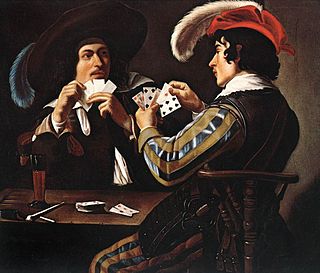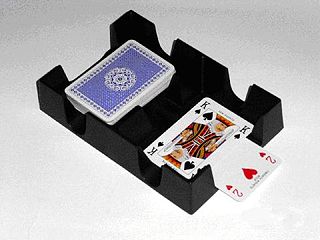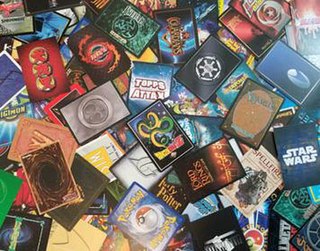
Plastic card sleeves are used to protect trading cards, game cards, and collectible card game cards from wear and tear. [1] The sleeves are a sheath of plastic into which a card is inserted. [2]

Plastic card sleeves are used to protect trading cards, game cards, and collectible card game cards from wear and tear. [1] The sleeves are a sheath of plastic into which a card is inserted. [2]
A wide variety of protective devices have been developed following the introduction of collectible card games, including the bulky "top-loader", a rigid plastic case with one open end (essentially a box for a single card) and the less-expensive simple "card sleeve", a card-sized envelope of clear plastic, with one end open.
Once collectible card games became popular after the advent of Magic: The Gathering , new technology was needed for two reasons. First, existing devices were not made with shuffling in mind: rigid top-loaders are effectively impossible to shuffle, and traditional card sleeves break easily during shuffling. Card sleeves also became more important because of Magic tournaments: cards that were worn were considered to be marked, and could not be used in tournament decks. The card sleeves were also a potential marking device: one drawback of traditional card sleeves was that they were typically slightly nonuniform, and therefore a potential way of marking cards in a deck on their own.

In 1995, the Ultra Pro company released the first card sleeves designed specifically for collectible card games, which they called deck protectors. Deck protectors were a tougher and more uniform version of traditional card sleeves, made of polypropylene, and specifically designed to snugly fit traditional cards. The first deck protectors were clear, but soon after, deck protectors were offered with opaque black backs, which would obscure the actual back of the card, allowing worn cards to be used without "marking" the deck. Other colors soon followed, and now a wide variety of deck protectors are available in many colors, and even with images on the back. These early sleeves would have the quality control problem of all the sleeves in the packet not being all evenly cut. Despite other companies like KMC and Player's Choice bringing this issue under control, it is still a common problem with many card sleeve manufacturers.
Today, players can get card sleeves specifically designed for other trading card games like Yu-Gi-Oh! . The increasing popularity of card games has resulted in the entry of competitors in the protective sleeve market, including companies such as Players' Choice, Dragon Shield, and Armor Shield.
With the increasing popularity of board games with game card components such as Settlers of Catan , Ticket to Ride and Dominion , Mayday Games launched card sleeves specifically for board games in 2008. These card sleeves are now offered in six sizes and two thicknesses for over 500 board games. In 2009 Fantasy Flight Games also entered the board-game card sleeve market with a line of premium thickness sleeves of its own.
Modern tournament rules for most trading card games allows (or even mandate) the use of card sleeves, and consider the card sleeves (if opaque) to be the real "back" of the card for the purposes of marking. This is also mandated to help players, judges, and tournament organizers to distinguish between player's decks and cards.

Blackjack is a casino banking game. It is the most widely played casino banking game in the world. It uses decks of 52 cards and descends from a global family of casino banking games known as "twenty-one". This family of card games also includes the European games vingt-et-un and pontoon, and the Russian game Ochko. Blackjack players do not compete against each other. The game is a comparing card game where each player competes against the dealer.

A card game is any game using playing cards as the primary device with which the game is played, be they traditional or game-specific. Countless card games exist, including families of related games. A small number of card games played with traditional decks have formally standardized rules with international tournaments being held, but most are folk games whose rules may vary by region, culture, location or from circle to circle.

In card games, to cut the cards is to split the deck into two packets by lifting one packet from the top and placing it face down beside the remainder; before placing the lower packet on top of it. This is typically done after the cards have already been shuffled, and the procedure is used just prior to the cards being dealt to the players. The aim of this is to reduce the possibility of cheating, for example, by knowing the bottom card. Cutting the cards is also a common way of determining the seating order at a card table, the partnerships or the first dealer.

Uno, stylized as UNO, is a proprietary American shedding-type card game originally developed in 1971 by Merle Robbins in Reading, Ohio, a suburb of Cincinnati, that housed International Games Inc., a gaming company acquired by Mattel on January 23, 1992.

Legend of the Five Rings is a fictional setting created by John Zinser, Dave Seay, Ryan Dancey, Dave Williams, DJ Trindle, Matt Wilson and John Wick and first published by a joint venture between Alderac Entertainment Group and ISOMEDIA in 1995. The setting primarily involves the fictional empire of Rokugan, though some additional areas and cultures have been discussed. Rokugan is based roughly on feudal Japan with influences from other East Asian cultures such as China, Mongolia and Korea. This setting is the basis for the Legend of the Five Rings Collectible Card Game as well as the Legend of the Five Rings Roleplaying Game. Legend of the Five Rings was also the "featured campaign setting" of the Oriental Adventures expansion to the third edition of Dungeons & Dragons, though this book is now out of print.

The Upper Deck Company, LLC, founded in 1988, is a private company primarily known for producing trading cards. Its headquarters are in Carlsbad, California, United States.

Call of Cthulhu: The Card Game is an out-of-print card game produced and marketed by Fantasy Flight Games. It is based on Chaosium's Call of Cthulhu role-playing game, the writings of H. P. Lovecraft, and other Cthulhu Mythos fiction. In 2008, Fantasy Flight moved the game over to its Living Card Game (LCG) format, which retains the deck-building aspect of collectible card games, but without the random distribution.

In duplicate bridge, a board is an item of equipment that holds one deal, or one deck of 52 cards distributed in four hands of 13 cards each. The design permits the entire deal of four hands to be passed, carried or stacked securely with the cards hidden from view in four pockets. This is required for in-person duplicate bridge tournaments, where the same deal is played several times and so the composition of each hand must be preserved during and after each play of each deal. When bridge is played online, the functions of the physical boards are replaced by the software.
This is a glossary of conjuring terms used by magicians.

Wyvern is an out-of-print collectible card game featuring dragons and wyverns battling for treasure. The game was produced by U.S. Games Systems, with the first, "Premiere Limited", card set launched in January 1995. In 1997, the "Kingdom Unlimited" edition was released, featuring 277 cards, and marking the end of production.
A proxy card is an easily acquired or home-made substitute for a collectible card. A proxy is used when a collectible card game player does not own a card, and it would be impractical for such purposes to acquire the card. This usually occurs when a player desires a card that is cost-prohibitive, or is "playtesting" with many possible cards. When doing intensive training for a competitive tournament, it often makes more sense to use proxy cards while figuring out which cards will be brought to the tournament. Another card is substituted and serves the same function during gameplay as the actual card would.

A poker dealer distributes cards to players and manages the action at a poker table.

The Pirates of the Caribbean Trading Card Game is an out-of-print collectible card game based on the two Disney films Pirates of the Caribbean: The Curse of the Black Pearl and Pirates of the Caribbean: Dead Man's Chest. Upper Deck Entertainment launched this title in June 2006 to roughly correspond to the release of the second film but canceled due to lack of interest.

A dealing shoe or dealer's shoe is a gaming device, mainly used in casinos, to hold multiple decks of playing cards. The shoe allows for more games to be played by reducing the time between shuffles and less chance of dealer cheating. In some games, such as blackjack, using multiple decks of cards can increase the house edge.

Chaotic is an out-of-print Danish collectible card game brought to the United States by Chaotic USA and 4Kids Entertainment, and distributed by TC Digital Games. It was released along with the open beta version of the online game on October 24, 2007. The card game is also featured in the animated series of the same name. As of 2014, the website is currently closed and the cards are no longer in production.

RoboRally is a board game for 2–8 players designed by Richard Garfield and published by Wizards of the Coast (WotC) in 1994. Various expansions and revisions have been published by both WotC and by Avalon Hill.

A collectible card game (CCG), also called a trading card game (TCG) among other names, is a type of card game that mixes strategic deck building elements with features of trading cards, introduced with Magic: The Gathering in 1993.
A sideboard, side deck, or side is a set of cards in a collectible card game that are separate from a player's primary deck. It is used to customize a match strategy against an opponent by enabling a player to change the composition of the playing deck.

A digital collectible card game (DCCG) or online collectible card game (OCCG) is a computer or video game that emulates collectible card games (CCG) and is typically played online or occasionally as a standalone video game. Many DCCGs are types of digital tabletop games and follow traditional card game-style rules, while some DCCGs use alternatives for cards and gameboards, such as icons, dice and avatars. Originally, DCCGs started out as replications of a CCG's physical counterpart, but many DCCGs have foregone a physical version and exclusively release as a video game, such as with Hearthstone.
Singles are individual trading or game cards sold by hobby stores, online stores, or by individual collectors. These individual cards are usually of higher value than contemporary cards which are often sold as "bulk" or as a personal collection. Ordinary collectible cards serve little function beyond memorabilia, but CCGs are also used in game tournaments. Generally, collectible card games (CCG) fetch initial higher prices than trading cards because of the dual nature of being both a game and a collectible. Prices will fluctuate for CCGs as cards become legal or illegal to play in certain game formats.